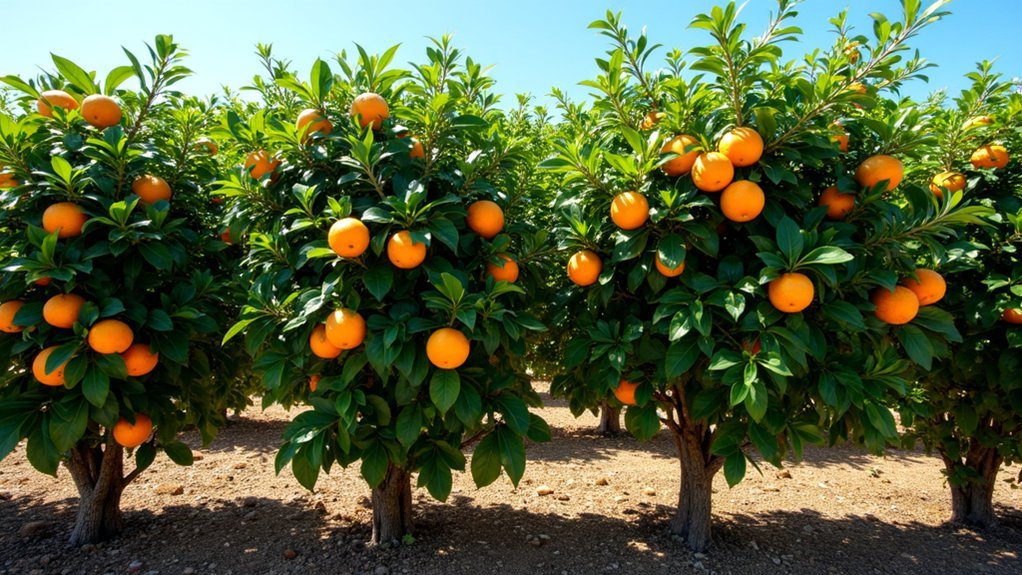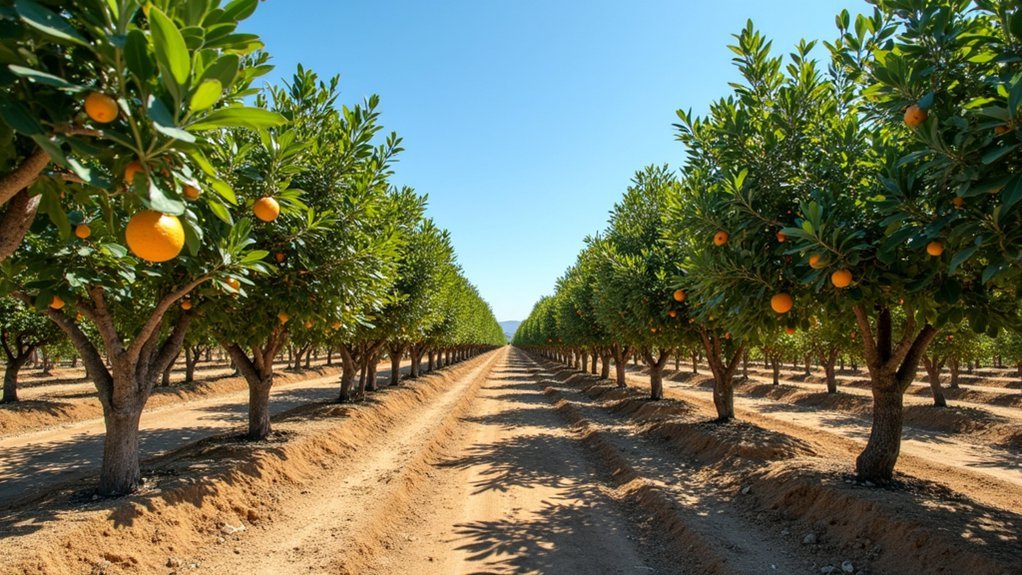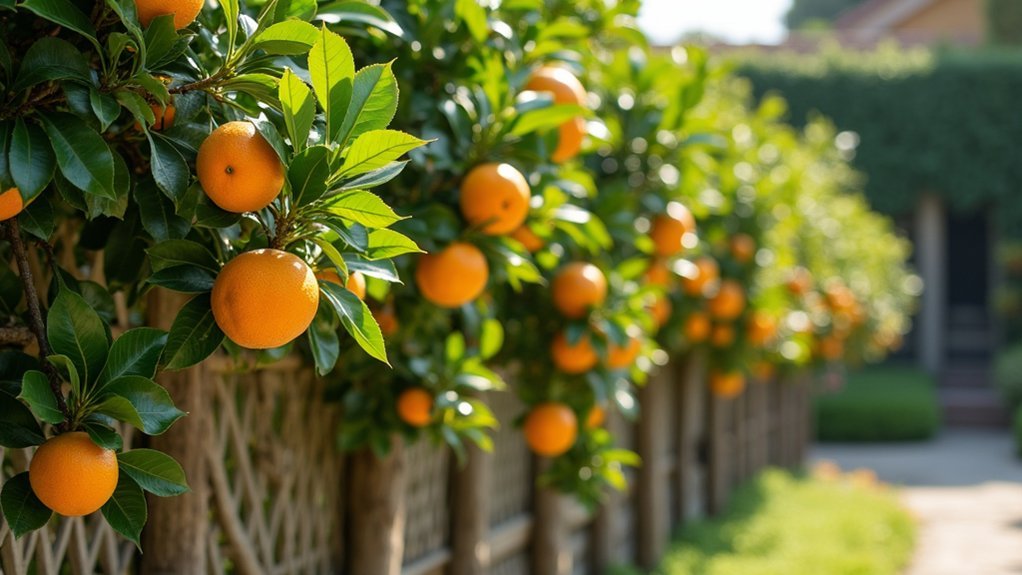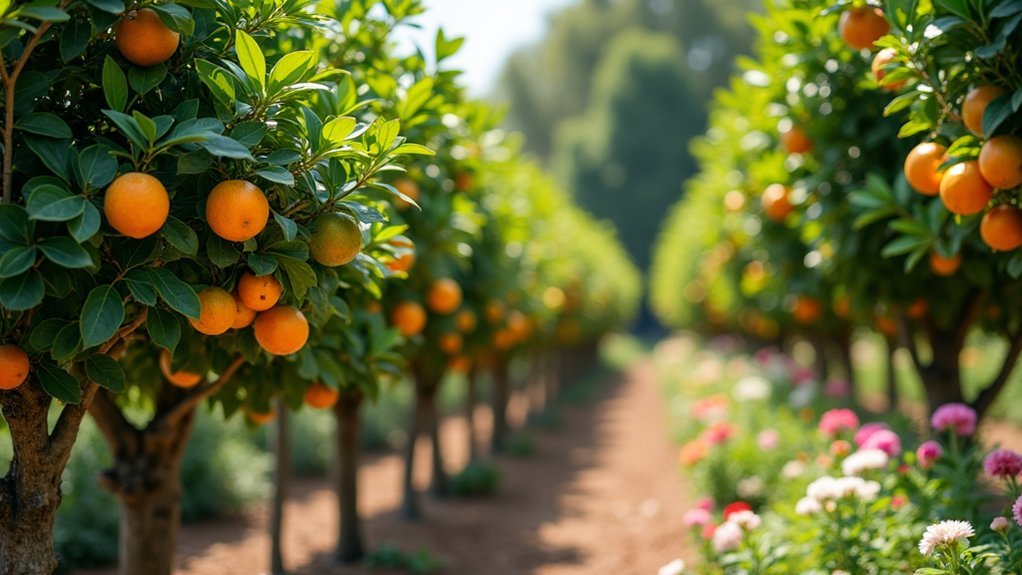Espaliered citrus trees create beautiful living fences while maximizing fruit production in limited spaces. Choose dwarf varieties and plant against south-facing walls where they’ll receive 6-8 hours of sunlight daily. Install sturdy guide wires 4-6 inches from the wall for proper air circulation, and train branches in a fan pattern for ideal growth. Prune in late winter, fertilize annually, and monitor for pests regularly. Your patience will yield both privacy and up to 100 fruits per tree.
Understanding Espaliered Citrus: Varieties Best Suited for Fencing

While many citrus varieties can be trained against fences, not all perform equally well in an espalier form. Dwarf citrus trees are your best option, offering manageable size and quicker fruit production than their standard counterparts.
When selecting fruit trees for your living fence, consider lemon and lime varieties, which thrive when trained against south-facing walls in Sunset zone 10a/9b. These different types maximize their exposure to sunlight, essential for ideal growth and fruiting.
The fan design works particularly well for citrus espaliers, with three branches extending outward from a central point. This approach among various espalier designs allows better air circulation and sun penetration to all parts of the tree, preventing disease and encouraging abundant fruit development throughout your living fence.
Site Selection and Preparing Your Support System
Because citrus trees crave sunshine, selecting the perfect location becomes your first essential step in creating an espalier. Choose a south-facing wall that receives 6-8 hours of direct sunlight daily to maximize your tree’s growth and fruit production. This ideal sunlight exposure guarantees espaliered trees thrive in their restricted growing pattern.
For your support system, install sturdy eyebolts with tensioned guide wires, maintaining 4-6 inches of space between the wall and tree for proper air circulation. A fan-shaped design works particularly well for citrus, spreading branches outward to capture maximum sunlight.
Before planting, verify your site offers well-drained, loamy soil for healthy root development.
Visualize your design by sketching branch placements with chalk, ensuring proper spacing for both maintenance access and visual appeal.
Training Techniques for Flat Citrus Growth Patterns

With your support system in place, it’s time to shape your citrus tree into a stunning espaliered masterpiece. Begin with young trees, guaranteeing their root system is established before training. In early spring, prune the main leader to about 2 inches above where you want first-tier branches to emerge, creating the foundation of your living fence.
| Technique | Timing | Purpose |
|---|---|---|
| Notching | Early spring | Stimulate dormant buds |
| Leader pruning | Late winter | Encourage lateral growth |
| Branch spacing | During growth | Guarantee even development |
| Side shoot pruning | As needed | Maintain 4-6″ spur length |
Maintain a 4-6″ gap between trees and wall for proper air circulation. Regularly secure branches to guide wires as they grow, gently training them into your desired pattern without stressing the plant.
Seasonal Care and Maintenance of Citrus Fences
After establishing your beautiful espaliered structure, seasonal maintenance becomes essential for both aesthetic appeal and fruit production.
Prune your citrus trees in late winter or early spring to maintain their shape and stimulate new growth, securing branches to guide wires as they develop.
Apply a balanced 12-12-12 fertilizer once annually in late February or March to support healthy growth and abundant fruiting.
Position your trees to receive 6-8 hours of full sun daily, especially important for wall-trained specimens.
Always maintain a 4-6 inch gap between the tree and wall to guarantee proper air circulation and disease prevention.
Don’t neglect watering during dry periods, as citrus trees are particularly susceptible to drought stress.
Regularly inspect leaves for signs of pests or diseases, addressing issues promptly to maintain your living fence’s vigor and beauty.
Harvesting Benefits: Privacy, Beauty, and Fruit Production

The triple reward of espaliered citrus trees transforms ordinary garden boundaries into functional works of living art.
You’ll enjoy enhanced privacy as these living fences mature, creating natural barriers that shield your outdoor spaces from prying eyes while adding stunning visual appeal.
The fan-shaped design isn’t just beautiful—it’s strategically beneficial.
This formation maximizes sunlight exposure and air circulation, leading to healthier fruit production with properly maintained trees yielding up to 100 fruits each.
You’ll appreciate how easily accessible the fruit becomes when harvest time arrives.
Beyond their privacy and productive benefits, espaliered citrus makes efficient use of limited garden space without casting excessive shade on neighboring plants.
Frequently Asked Questions
How Long Do Espalier Trees Live?
Your espalier trees can live 15-30 years with proper care. Their lifespan depends on the species, growing conditions, and maintenance. Regular pruning, healthy soil, adequate sunlight, and pest management will maximize their longevity.
Can You Trellis Citrus Trees?
Yes, you can trellis citrus trees. They’re ideal for this technique, especially younger trees on dwarf rootstock. You’ll need to regularly prune them to maintain the desired fan or cordon shape for maximum growth.
How Close to a House Can You Plant a Citrus Tree?
You should plant citrus trees 6-10 feet away from your house for proper growth. For espaliered citrus, keep them at least 6 inches from walls to maintain airflow and prevent moisture-related diseases.
How Much Space Does an Espalier Tree Need?
You’ll need at least 6 inches between your espalier tree and the wall, with a height of 4-6 feet and width of about 6 feet. Make certain it gets 6-8 hours of sunlight daily.
In Summary
Creating a living citrus fence through espalier techniques rewards you with privacy, beauty, and homegrown fruit all in one stunning package. You’ll enjoy the satisfaction of training these trees into functional art while maximizing limited space. Whether you’ve chosen lemons, kumquats, or mandarins, your espalier citrus fence will become a conversation piece that delights your senses year-round with fragrant blossoms and colorful harvests.





Leave a Reply